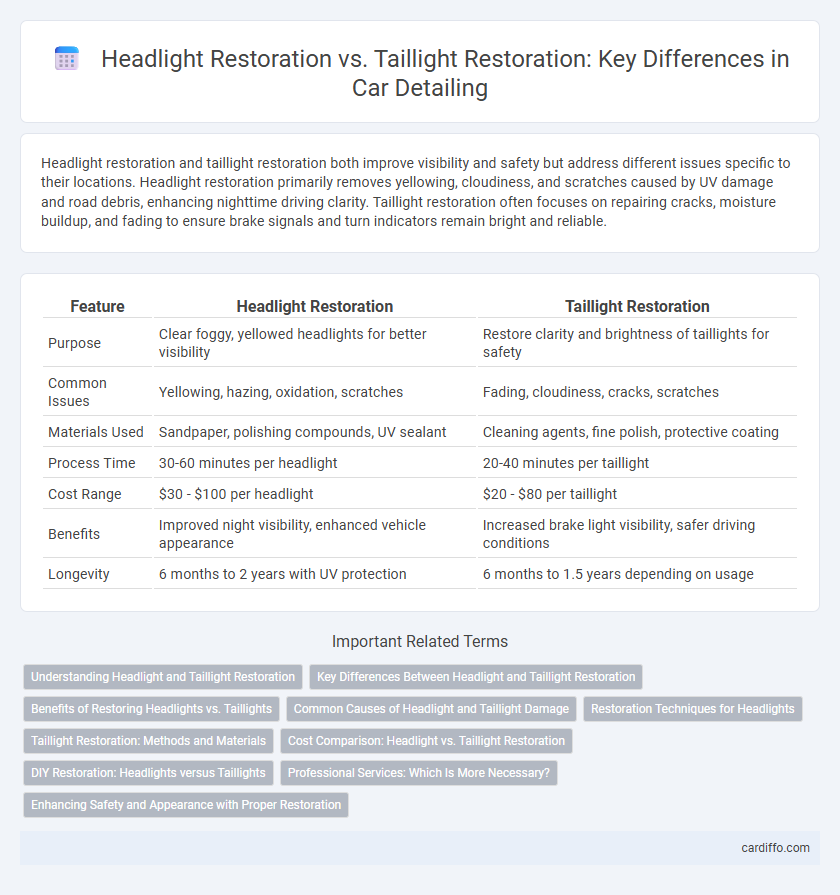Headlight restoration and taillight restoration both improve visibility and safety but address different issues specific to their locations. Headlight restoration primarily removes yellowing, cloudiness, and scratches caused by UV damage and road debris, enhancing nighttime driving clarity. Taillight restoration often focuses on repairing cracks, moisture buildup, and fading to ensure brake signals and turn indicators remain bright and reliable.
Table of Comparison
| Feature | Headlight Restoration | Taillight Restoration |
|---|---|---|
| Purpose | Clear foggy, yellowed headlights for better visibility | Restore clarity and brightness of taillights for safety |
| Common Issues | Yellowing, hazing, oxidation, scratches | Fading, cloudiness, cracks, scratches |
| Materials Used | Sandpaper, polishing compounds, UV sealant | Cleaning agents, fine polish, protective coating |
| Process Time | 30-60 minutes per headlight | 20-40 minutes per taillight |
| Cost Range | $30 - $100 per headlight | $20 - $80 per taillight |
| Benefits | Improved night visibility, enhanced vehicle appearance | Increased brake light visibility, safer driving conditions |
| Longevity | 6 months to 2 years with UV protection | 6 months to 1.5 years depending on usage |
Understanding Headlight and Taillight Restoration
Headlight restoration improves nighttime visibility and driving safety by removing oxidation and yellowing from the polycarbonate lens, restoring clarity and brightness. Taillight restoration focuses on enhancing rear light effectiveness by eliminating cloudiness and scratches that can diminish brake light and turn signal visibility. Both processes use sanding, polishing, and sealing techniques to extend light durability and maintain vehicle aesthetics.
Key Differences Between Headlight and Taillight Restoration
Headlight restoration primarily targets improving visibility and safety by removing oxidation, yellowing, and cloudiness from the lens, which typically affects light output and clarity. Taillight restoration focuses on maintaining the brightness and color accuracy of brake and signal lights to ensure proper signaling and legal compliance, often addressing cracks, scratches, and fading caused by UV exposure. The key difference lies in functionality emphasis: headlights require enhanced light transmission for night driving, while taillights need color preservation and surface integrity to communicate signals effectively.
Benefits of Restoring Headlights vs. Taillights
Restoring headlights significantly improves nighttime visibility and enhances road safety by providing brighter and clearer light output. Taillight restoration primarily boosts rear visibility, reducing the risk of rear-end collisions and improving communication with other drivers. Headlight restoration often yields greater safety benefits due to its critical role in forward illumination and overall driving awareness.
Common Causes of Headlight and Taillight Damage
Headlight and taillight damage commonly results from UV exposure, road debris, and environmental contaminants leading to oxidation and discoloration. Headlights often suffer from yellowing and cloudiness due to prolonged sun exposure, while taillights are more prone to cracks and fading caused by impacts and harsh weather conditions. Both types of damage reduce light output and visibility, necessitating timely restoration for safety and aesthetic purposes.
Restoration Techniques for Headlights
Headlight restoration primarily involves wet sanding, polishing, and applying UV-resistant clear coats to remove oxidation and prevent future yellowing, ensuring maximum light output and road safety. Unlike taillight restoration, which often deals with simpler surface scratches and fading, headlight restoration requires precise abrasive techniques to restore clarity without damaging the lens. Innovative tools such as rotary polishers and specialized polishing compounds enhance the effectiveness of these restoration techniques, delivering professional-grade results.
Taillight Restoration: Methods and Materials
Taillight restoration involves removing oxidation, scratches, and yellowing using methods like wet sanding, polishing, and the application of UV-resistant clear coats. Materials commonly used include fine-grit sandpaper, plastic polish, rubbing compounds, and protective sealants that restore clarity and prevent future damage. This process improves safety by enhancing light output and preserves vehicle aesthetics by maintaining a crisp, clear taillight appearance.
Cost Comparison: Headlight vs. Taillight Restoration
Headlight restoration typically costs between $50 and $100 per light, reflecting the complexity and size of the headlight lens compared to taillights, which usually range from $40 to $80. The price difference stems from the materials and labor intensity required, as headlights often use more durable polycarbonate lenses that require specialized polishing and UV sealants. Restoration shops may also charge more for headlights due to higher demand and safety implications, making taillight restoration a more budget-friendly maintenance option.
DIY Restoration: Headlights versus Taillights
DIY headlight restoration often requires removing oxidation and yellowing caused by UV exposure, improving light output and road safety, while taillight restoration typically focuses on eliminating minor scratches and cloudiness to enhance visibility. Headlights usually involve more intensive sanding and polishing steps due to their larger surface area and higher exposure to grime, whereas taillights may be restored using simpler polishing techniques. Both processes benefit from using quality abrasives, polishing compounds, and UV sealants to prolong clarity and functionality.
Professional Services: Which Is More Necessary?
Professional headlight restoration addresses hazing and yellowing that significantly impair night visibility, enhancing both safety and driving experience. Taillight restoration, while less critical for direct visibility, improves brake light clarity and overall vehicle aesthetics, contributing to safer rear signaling. Prioritizing headlight restoration in professional detailing services is more necessary due to its direct impact on driver vision and accident prevention.
Enhancing Safety and Appearance with Proper Restoration
Headlight restoration improves nighttime visibility by removing oxidation and yellowing, significantly enhancing driver safety and vehicle appearance. Taillight restoration restores clarity to rear lights, ensuring brake signals and indicators are highly visible to other drivers and preventing potential accidents. Both services extend the lifespan of lights and maintain the vehicle's value by preserving OEM quality and clarity.
Headlight Restoration vs Taillight Restoration Infographic

 cardiffo.com
cardiffo.com